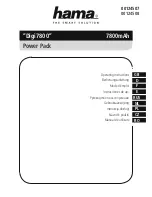
www.pulsar.pl
DSO-PRA
15
7. INSTALLATION.
7.1. Requirements.
DSO should be mounted by a qualified installer, holding relevant permits and licenses (applicable and
required for a given country) for 230 / 400V AC and low-voltage installations. Installer should be trained in
commissioning and operation of power supply system of DSO by Pulsar Company.
Electrical system shall follow valid standards and regulations. DSO cabinet should be mounted in such a
way to provide both front and rear access for service personnel. Always ensure a free, convection air flow around
cabinet.
As power supply unit of DSO cyclically runs a periodic battery test, during which connection resistance is
measured, special attention should be paid to proper installation of battery cables.
7.2. Installation procedure.
CAUTION!
Before installation, make sure that the voltage in the 230 V / 400 V power-supply circuit is cut off.
Selection of installation cables should take account §187 of the Regulation of the Minister
of Infrastructure on technical conditions to be met by buildings and their location.
1. Equipment should be installed in appropriate compartments of cabinet.
2. Make additional protective conductor connections between housings of devices and earthing plate (set in a
ziplock bag)..
3. Connect battery with power supply board paying special attention to correct polarity. Battery should be
connected in series using special connectors (included). Insert fuses into battery sockets, attach circuits
and install protective cover.
4. Connect power cables (230 / 400 V AC) to L1-L2-L3-N contacts of power supply (or L-N in case of a single-
phase connection).
5. Connect ground wire to clip marked by earth symbol
. Use a five-core cable (or three-core cable for a
single-phase connection) with a yellow and green PE protection wire to make connection.
Fig. 13. Connection to the power system
– a single-phase 230 V AC connection.
Fig.14. Connection to the power system
– 3-phase 400 V AC connection.


































